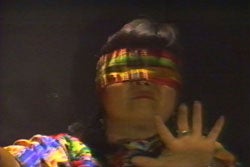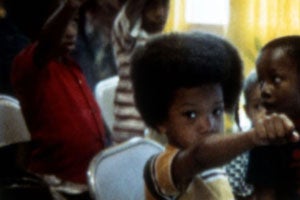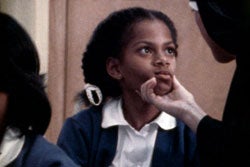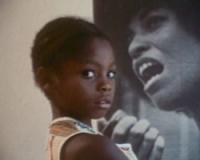Shannon Kelley, Head of Public Programs at UCLA Film & Television Archive was onto something this past Friday night when he said that the evening’s program of shorts was a particularly effective representation of many of the themes explored by the L.A. Rebellion films and filmmakers. Each of the films, though short in length, was dense in content, wrought with social, political and cultural tension. But perhaps the most telling aspect tenuously linking the short films presented in that program with those of the rest of the movement is the palpable sense of place, struggling for and against the identities mediated within. In this article, we will look at the screened works: Define (1988), Ujamii Uhuru Schule (1974), Brick by Brick (1982), Rich (1983) and Shipley Street (1981) from the perspective of the different students that attended the screening.
The Tuesday prior to the October 21st screening, one of the filmmakers, O.Funmilayo Makarah, visited our graduate seminar L.A. Rebellion class. While with us, she spoke about her experiences at UCLA and her body of work, including her piece Define. Speaking to her own work, Makarah emphasized that Define is about solidarity, a theme which pervades the film from its genesis to the finished product.
The project came about when fellow UCLA student artist Yreina Cervantez (the second woman in the film) came under pressure from institutional powers regarding her work. In order to show their support of their colleague, Makarah and Kelly Hashimoto made Define (1988). The film’s final image shows the three women with their arms around each other’s shoulders, an unbreakable chain of women of color who choose to stand proudly outside the dominant culture.

The film also demonstrates the cross-cultural solidarity that defined the L.A. Rebellion. Historically, the primary emphasis and in this current film series is on the Black contributions to the movement, but many point out that other groups participated as well. The presence of three women from different racial/ethnic groups in Define speaks to the intersections that occurred across cultures in response to the shared problems of racism and ignorance.
One of the most powerful images in Define was the segment featuring Kelly Hashimoto as a geisha hanging from a tree by her hair. Hashimoto distributed fliers on campus stating that there would be a “hanging at noon,” and then enacted it as a performance piece for the gathering crowd. Although Makarah could not recall some of the other specifics regarding the preparation for the piece, she had rather strong memories of the “frat boys” in the crowd who were shouting sexually explicit verbiage at Hashimoto as she hanged there.
The fact that students found nothing questionable in behaving that way towards women is troubling in and of itself, but it becomes even more so when you realize how these “frat boys” so blatantly ignored the message of Hashimoto’s demonstration. She had hanged the geisha—the eroticized stereotype of the Asian female—on display, but it was not for the “frat boys’” voyeuristic pleasure and sexual consumption. Rather, the hanging was meant to interrogate and ultimately reject that stereotype into which the “frat boys” had placed her. The fact that Hashimoto’s message could be so grossly misconstrued is indicative of the deep-seated attitude in campus culture towards Asians that was most recently manifested by Alexandra Wallace in the now-infamous “Asians in the Library” YouTube video. That the struggle continues today is a sentiment echoed by Makarah in her other work (most notably Diversity) and in person.
Still, Makarah does not end the film by dwelling on despair. Rather, she ends with “My name is Yreina Cervantes” on a loop over the aforementioned image of the three women. Thus there is a glimmer of hope to be found in solidarity—we do not have to be defined by the dominant culture.

The next film screened was Don Amis’ short film entitled Ujamii Uhuru Schule Community Freedom School (1974), a Project One film and Jim Morrison award-winner from Amis’ undergraduate years at UCLA. In his oral history, Amis says that he was “more interested in doing film differently…to take the camera, use the film to show what was going on.” And that’s exactly what he achieved with Ujamii Uhuru Schule. The camera occupies a seemingly invisible vantage point, providing insight into the lives of a people and place that might have otherwise felt intruded upon. Amis speaks to the camera’s seamless presence as being a process in which, after one visit he “wasn’t a stranger coming into their midst” anymore, allowing for a sense of hyperrealism that provided emotional access into a space we might not have ever been afforded.
“I thought it was a good visual. It was a lot of activity, a lot of kids, adults, a lot of cultural history going on, a lot of self awareness, a lot of self respect, a lot of teaching about things that weren’t being taught any place else at the time.” -Don Amis, Oral History
Ujamii Uhuru Schule is not only about the Swahili for Community Freedom School as a physical space, it is about the ways in which cultures converge in that space. There is a clear dichotomy between dominant culture and the African American culture the school seeks to empower, made apparent by the alternative education at work in the school. The narraration highlights the tension between these two cultural factions, describing dominant culture’s failure to acknowledge and adequately represent African American culture. Ujamii Uhuru Schule is a place that seeks to right this wrong by creating a space for African Americans who have been stripped of their cultural ties and alienated by dominant society.
The film is saturated with people, mostly children, each poised in some form of active participation. Fists thrust in the air chanting in Swahili, punches thrown in demonstration, there is an aggressiveness to the schools attempt to hold onto its cultural heritage. Ujamii Uhuru Schule is above all, as Amis noted in the Q&A following the screening, a place to think. Young children sit sprawled on the floor, receptacles of cultural knowledge imparted on them by community members invested in the education and preservation of their community’s identity. A sense of community, a sense of cultural, political and social identity each affords this place a sense of hope in retaining ones cultural virtues. It is this sense of place, a sense of community born of alienation that gives strength to Don Amis’ powerful images, and makes our insight into this place all the more important.
A good companion piece to this was the film that showed a little later on in the program, Brick by Brick (1982), a film by filmmaker Shirikiana Aina. Brick by Brick begins with a panoramic shot of Capitol Hill. It is a high angle shot looking down on a city glimmering with the majesty of a just country. Slowly the camera pans across the city lights, then lowers and zooms in on the home of a black woman residing in a basement apartment with her sister and their five children.

Juxtaposing the voices of the city’s Black residents with the official statements of city government officials underscores the fundamental injustice experienced by poor people of color in the nation’s capital. Aina stated that she made the film partly to atone for her feelings of guilt for attending Howard University at a time when Black residents were being pushed from their homes, and partly to allow residents of Washington’s Black residents to speak their truth to eminent domain practices.
During the film Aina allows us to see how generations of Black families adjust to overcrowding by moving in with family members and pooling their resources. She also shows us how they fight against building owners who manipulate city codes to force residents out. She mentions that many of the current laws protecting renters in Washington D.C. today originated with activist work done by black city residents in the 1970’s. Brick by Brick reveals the reality poor Black communities face amidst a middle class struggle for comfort, racial disparities and power struggles by wealthy landowners.
As Aina shows us blighted apartment buildings inhabited by Black residents attempting to maintain their dignity and a sense of community we begin to understand this struggle is not unique to Black Americans. Peoples all around the world were fighting against injustice and displacement by wealthy classes who wished to enjoy unlimited freedom and luxury without responsibility for the poverty it causes. The struggle continues.
Though the films varied in their approach and delivery, these three were concerned with issues of freedom. They did so in distinct ways, there was the questioning whether or not one was truly free to unabashedly embrace one’s cultural identity in Define, there was also the examining of one community’s assertion of their freedom and will in Ujamii, and there was the exposing of the fundamental threat on freedom present in a government that has systemically taken away the one’s freedom to exist in physical spaces in Brick by Brick. Freedom was what was at stake for all three films.
While the previously discussed films engage the audience in a different kind of atmosphere and diegetic proposal, these next two films are of a slightly different build, but no less important. While Brick by Brick and Ujamii may seem more outwardly political and socially strident than Rich or Shipley Street, it is the display of the home life against the social stratosphere that gives these films a connective strand. While a film like Rich displays the struggles of a family that has it quite a bit better than the families in Brick by Brick, it is still the ideas of space that bring all of these films together and function as their connective tissue. The shots of the characters at Watts Towers in Rich were integral and analogous to many of the messages from Brick by Brick or Ujamii. It was just being enacted with a different narrative. The signifiers for socio-political change were still visually present.

In S. Torriano Berry’s Rich (1983), education also plays an essential role in overcoming systemic oppression. The main character, Rich, receives good grades and maintains success in school, despite being raised by a single working mother after his father died in Vietnam. Rich’s dream is to attend a university and determine his own future, but on his graduation day, his mother asks him to instead accept a job offer from her wealthy white employer, for whom she works as a housekeeper. Rich is adamant in his refusal, reinforcing the film’s message that African Americans should not passively accept lowered expectations or subservience to white people, but should instead expect and demand greater opportunities for advancement. Rich’s mother undergoes an interesting change of her own; she starts off passively accepting her employer’s unreasonable request to miss her own son’s graduation, but then has her moment of clarity and walks out on the job. This leads to her turning down the job offer on behalf of her son, and accepting Rich’s point of view that he should have the right to choose his own future.

Both Shipley Street (1981) and Rich (1983) forefront education as a vital component of how young African Americans can begin navigating a systematically oppressive society. Jacqueline Frazier’s Shipley Street tells the story of a family’s struggles with a racist classroom environment. An interesting aspect of this film is its switch in focus from the father to the daughter as the film progresses. The film opens with the father’s frustration at his denial of a promotion, based in racial nepotism, but after he returns home and rejoins his family the film slowly moves our attention to Lana’s troubles in school. This shift creates a logical connection between the two characters’ experiences: not only is the inequality he suffers at his job echoed by his daughter’s unfair treatment at school, but his difficulties at work inform his decision to pay for an expensive education for his daughter, as an education is the only way he sees to break the cycle and enable his daughter to have a better life than he has.
All of the films that were shown on Friday, October 21, 2011, were cinematic siblings. They all occupied the same zone, even if it was during different years. They all discussed issues of freedom and prejudice, cultural genocide and reclaiming or keeping one’s identity amidst hardship. In many cases, a strong sense of identity became transposable with a sense of “home” or “belonging,” as seen in Shipley St and Brick by Brick. In all cases, however, the medium of cinema was used to progress these filmmakers’ ideas about the way the world was going and what their place was within it, and it was clearly done with skill, candor and might.
—Jenni Fong Govea, Iyabo Kwayana, Ariel Schudson, Rachel Wilson, Dan Weisman and Bryan Wuest






 Mobile Navigation
Mobile Navigation

